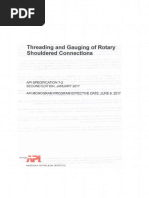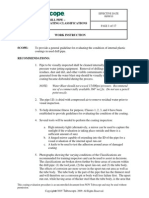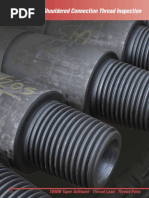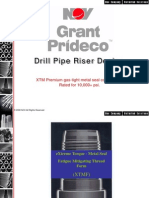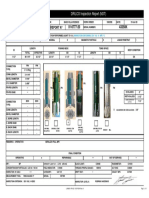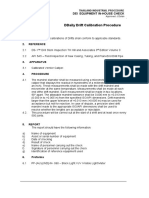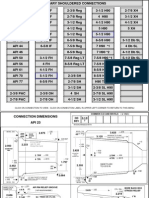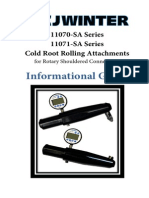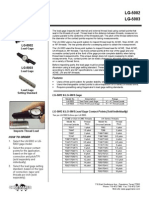LG5002 Ops
LG5002 Ops
Uploaded by
RSR_2K5364Copyright:
Available Formats
LG5002 Ops
LG5002 Ops
Uploaded by
RSR_2K5364Original Title
Copyright
Available Formats
Share this document
Did you find this document useful?
Is this content inappropriate?
Copyright:
Available Formats
LG5002 Ops
LG5002 Ops
Uploaded by
RSR_2K5364Copyright:
Available Formats
Lead Gage Operation Manual Model LG-5002
2
Copyright 2014 Gagemaker. All rights reserved
2014 Gagemaker, LP
Lead Gage Operation Manual Model LG-5002
Copyright 2014 Gagemaker. All rights reserved
3
Contents
Introduction
Technical Support 4
Product Information and Updates 4
Parts List 5
Setup Procedures
Setting Up the Lead Gage 6
Adjusting the Lead Gage 9
Zeroing the Lead Gage 11
Operating Procedures
Inspecting Parts 14
Care and Maintenance
Replacing the Indicator 16
Maintenance Tips 18
Warranty Information 18
Lead Gage Operation Manual Model LG-5002
4
Copyright 2014 Gagemaker. All rights reserved
Congratulations! Your decision to purchase a Gagemaker product above all others on the market
demonstrates your confidence in our quality and workmanship.
To ensure the high performance and operation of our product, we urge you to use the included reference
materials. They contain important information for proper setup and use of the equipment. Also, we
recommend that you follow the care and maintenance tips in this manual to keep the equipment working
in top condition.
If your questions have not been addressed in our reference materials, contact your local
representative or a customer service representative at 713-472-7360.
I ntroduction
The lead gage inspects both internal and external thread lead using contact points that seat in the
threads of a part. Thread lead is the distance from a point on a thread to a corresponding point on the
next thread turn, measured parallel to the thread axis. The pitch of the thread determines the diameter
of the contact points required for taking measurements (refer to the tables for ACME, Stub ACME, UN
and API Threads in the Setup Procedures section of this manual for contact point model numbers).
Gagemakers lead gage, Model LG-5002, uses two contact points to inspect thread lead. One fixed
contact point at the rear of the gage and one moveable contact point at the front of the gage provide
complete stability when taking thread lead measurements.
Before inspecting parts, the lead gage must be preset to a nominal predetermined dimension, using a
lead gage setting standard. These setting standards are manufactured according to ANSI and API
specifications with grooves ground at precise increments. The increments are normally set at
intervals from 1 4. Lead standards are available for ACME, Stub ACME, UN and API threads (refer
to the table in the procedure for Zeroing the Lead Gage in this manual for lead standard model
numbers).
To inspect parts, seat the rear contact point of the gage into the thread of the part. Then, seat the
moveable contact point at the front of the gage in the thread. Apply pressure to the nose of the gage
with an index finger and sweep from side to side to get an indicator reading. It is recommended that the
gage be zeroed periodically during use to maintain accurate readings.
Technical Support
Phone: 713-472-7360
Hours: Monday Friday 8AM 5PM (CST)
Product Information and Updates
Visit our web site at: www.gagemaker.com
Lead Gage Operation Manual Model LG-5002
Copyright 2014 Gagemaker. All rights reserved
5
Parts List
Take some time to become familiar with all the parts that make up the lead gage by reviewing the
labeled diagram below. The part names are important for understanding the operating
instructions.
Item Description Part Number Qty Item Description Part Number Qty
1 Main Body LG-5002-A1 1 10 Bushings LG-5002-A10 2
2 Adjustment Knob LG-5002-A2 1 11 Indicator Push Rod LG-5002-A11 1
3 Clamp Screw LG-5002-A3 1 12 Indicator Push Rod Sleeve LG-5002-A12 1
4 Thru Hole Clamp LG-5002-A4 1 13 Indicator Hold Down Screws LG-5002-A13 4
5 Threaded Clamp LG-5002-A5 1 14 Yoke Hold Down Screws LG-5002-A14 4
6
Moving Contact Point
Assembly
LG-5002-A6 1 15
Contact Point Assembly Hold
Down Screws
LG-5002-A15 4
7 Front Yoke LG-5002-A7 1 16 Indicator/Transfer Contact Post LG-5002-A16 1
8 Back Yoke LG-5002-A8 1 17 Indicator * 80-403* 1
9 Fixed Contact Point Bar LG-5002-A9 1 18 Contact Points** T072** 2
* A higher resolution indi cator is availabl e.
**T072 contact points are shipped standard, but other contact points are avai lable.
1 2
3
4
5
6
7
8
9
10
11
12
13
14
15
16
17
18
18
Lead Gage Operation Manual Model LG-5002
6
Copyright 2014 Gagemaker. All rights reserved
Setup Procedures
Setting Up the Lead Gage
Materials Needed:
Lead gage Calipers
Contact points (2) Paper clip
Setting up the lead gage, involves installing the proper size contact points for the application (refer to the
table below for selecting the proper model contact point for ACME, Stub ACME, UN threads or API
threads).
ACME or Stub ACME Threads UN Threads
Thread Pitch
Contact Point
Model Number
Thread Pitch
Contact Point
Model Number
1 pitch T531T 1 pitch T562
1.5 pitch T344T 2 pitch T288
2 pitch T266T 3 pitch T188
2.5 pitch T219T 3.5 pitch T188
3 pitch T188T 4 pitch T144
3.5 pitch T144T 4.5 pitch T128
4 pitch T128T 5 pitch T115
5 pitch T105T 5.5 pitch T105
6, 7 pitch T090T 6 pitch T096
8 pitch T062T 8 pitch T072
10 pitch T050T 10 pitch T057
12 pitch T041T 11 &12 pitch T050
14 pitch T041T 14 pitch T041
16 pitch T032T 16 pitch T041
18 pitch T032
API Threads
Connection Type
Contact Point
Diameter
Thread Pitch
Contact Point
Model Number
Hughes Slim Line H-90 0.235 3 T235
All Hughes H-90 0.200 3 T200
API Rotary Shouldered Connections 0.144 4 T144
API Rotary Shouldered Connections 0.128 4 T128
API Rotary Shouldered Connections 0.115 5 T115
Truncated for Extreme Line 0.105 5 T105T
API Rotary Shouldered Connections 0.096 6 T096
API Tubing, Casing and Line Pipe 0.072 8 T072
Buttress Casing - Lead 0.062 5 T062
API Tubing and Line Pipe 0.057 10 T057
API Line Pipe 0.050 11 T050
API Line Pipe 0.041 14 T041
API Line Pipe 0.032 18 T032
API Line Pipe 0.021 27 T021
Lead Gage Operation Manual Model LG-5002
Copyright 2014 Gagemaker. All rights reserved
7
Setting Up the Lead Gage (continued)
1. Determine interval of measurement required
for the inspection by counting thread roots
(example shows 8 TPI).
The increments in the lead gage are set at
intervals from 1 4.
2. Select the correct contact points to install in
the gage, based on the connection thread
type and pitch size (refer to tables on previous
page).
3. Verify the diameter of the contact point ball
using calipers or a micrometer.
4. Install a contact point into the moveable
holder at the front of the gage.
8 4 0
Lead Gage Operation Manual Model LG-5002
8
Copyright 2014 Gagemaker. All rights reserved
Setting Up the Lead Gage (continued)
5. Install a contact point into the fixed holder at
the rear of the gage.
Do not use pliers to tighten the contact
points, as damage may result.
6. Once installed, insert a paper clip into the hole
in each contact point and tighten.
!
Lead Gage Operation Manual Model LG-5002
Copyright 2014 Gagemaker. All rights reserved
9
Adjusting the Lead Gage
Materials Needed:
Lead gage Hex wrench
1. Loosen the indicator clamp. Loosen the screw
at the front of the gage with a hex wrench to
loosen the rear contact point.
2. Place the gage on the standard and turn the
adjustment knob at the rear of the gage until
the rear contact point is aligned with the
appropriate groove
3. Continue rotating the adjustment knob until
the indicator needle makes one full revolution
of preload.
Lead Gage Operation Manual Model LG-5002
10
Copyright 2014 Gagemaker. All rights reserved
Adjusting the Lead Gage (continued)
4. Lock the indicator clamp.
5. Tighten the screw on the front of the gage with
a hex wrench.
Lead Gage Operation Manual Model LG-5002
Copyright 2014 Gagemaker. All rights reserved
11
Zeroing the Lead Gage
Materials Needed:
Lead gage Lead gage standard
The lead gage performs a comparative inspection between a fixed standard and the threaded part.
Before applying the gage to a part, you must zero the lead gage on the proper standard.
Based on the type of connection being inspected, locate the proper lead gage standard in the table
below to ensure consistent and accurate readings. The lead gage should be zeroed on a standard once
during each shift, at a minimum.
Connection Type
Taper
(in/ft)
Threads
per Inch
Lead Gage
Standard Model
Number
API 8-Round Casing, Tubing & Drill Pipe
All 10-Round Tubing
8 & 10 LS-1001
Straight Threads, 6 -18 Pitch, 4 Length8 & 10 V Form
Tubing (straight)
0 8 & 10 LS-1002
11 V API Line Pipe 11 LS-1003
Straight Threads, Line Pipe 0 11 LS-1004
API Buttress Casing, Internal/External 14 - 13 5 LS-1005
API Buttress Casing, Internal/External 16 &Larger 1 5 LS-1006
6 API Reg
4, 5 - 6 API Full Hole
2 , 3 5 Hughes Xtra Hole
2 , 2 , 4 Hughes Slim Hole
2 - 5 API INT Flush
API Numbered Connections #23 - #50
2 4 LS-1007
5, 7 , 8 API Reg
API Numbered Connections #56 - #77
3 4 LS-1008
2 - 4 Reg
3 , 4 API Full Hole
3 5 LS-1009
API Numbered Connections #10, #12, #13, #16
M.T. (Macaroni Tubing)
2 - 3 PAC
2 4 American Open Hole
1 4 LS-1010
3 - 6 H-90 2 3 LS-1011
7 - 8 H-90 3 3 LS-1012
2 - 3 Slimline H-90 1 3 LS-1013
Straight Threads, 1-5 pitch, 4 length N/A N/A LS-5001
Straight Threads, 6-18 pitch, 4 length N/A N/A LS-5002
Lead Gage Operation Manual Model LG-5002
12
Copyright 2014 Gagemaker. All rights reserved
Zeroing the Lead Gage (continued)
1. Loosen the indicator clamp and place fixed
contact point in the second groove of standard.
2. Place moveable contact point into the first
groove of standard.
3. Sweep the moveable contact point from side to
side in order to obtain the smallest indicator
reading (needle changes direction).
For Non-V threads, pull the lead gage
toward the load flank of the groove in the
standard.
For V threads, be sure the contact points
touch both flanks of the groove in the
standard.
!
Lead Gage Operation Manual Model LG-5002
Copyright 2014 Gagemaker. All rights reserved
13
Zeroing the Lead Gage (continued)
4. With the two contact points properly seated in
the grooves of the standard, turn the indicator
dial to align the needle with zero.
5. Tighten the indicator clamp.
Lead Gage Operation Manual Model LG-5002
14
Copyright 2014 Gagemaker. All rights reserved
Operating Procedures
Inspecting Parts
Materials Needed:
Lead gage Inspection report
Part
Inspecting parts using the lead gage involves placing the lead gages contact points in the flanks of the
thread to obtain an indicator reading. The two-point system on the lead gage provides accurate readings.
1. Place the fixed contact point into the thread
next to the first scratch on the part (or first full
thread).
2. Rock the gage forward and seat the moveable
contact point into the thread. Use your index
finger to apply just enough pressure to
maintain the gages contact with the thread
flanks.
Lead Gage Operation Manual Model LG-5002
Copyright 2014 Gagemaker. All rights reserved
15
Inspecting Parts (continued)
3. Using the fixed contact point as the pivot point,
sweep the gage left and right to locate the
smallest indicator reading. Take note of the
indicator reading.
4. Move the gage to the next thread, repeat the
sweeping action and note the indicator reading.
5. Move the gage to a thread at the rear of the
part and seat the moveable contact point in the
last full thread.
6. Sweep the gage from side to side in order to
obtain an indicator reading. Take note of the
reading.
7. Record the maximum lead error on an
inspection report.
8. During the inspection process, periodically
verify the gages repeatability by placing it on
the lead standard.
Lead Gage Operation Manual Model LG-5002
16
Copyright 2014 Gagemaker. All rights reserved
Care and Maintenance
Replacing the Indicator
Materials Needed:
Lead gage Lead gage standard
Indicator with extension and point installed. Small Phillips head screwdriver
1. Using a small Phillips head screwdriver,
remove the four screws from the back of the
gage.
2. Loosen the bezel clamp screw. Remove the
screw and the bezel clamp.
3. Slide the indicator assembly out of the gage
body.
Lead Gage Operation Manual Model LG-5002
Copyright 2014 Gagemaker. All rights reserved
17
Replacing the Indicator (continued)
4. Slide the new indicator assembly, with point
lever attached, back into the body of the lead
gage.
5. Replace the bezel clamp and screw.
6. Replace the four Phillips head screws into the
back of the gage body and tighten.
Lead Gage Operation Manual Model LG-5002
18
Copyright 2014 Gagemaker. All rights reserved
Maintenance Tips
Keep all unprotected metal surfaces coated with light oil.
Avoid dropping the gage or subjecting it to any vibration or impact.
Keep the gage dry and away from any machine coolant spray.
Do not force the movement of any of the mechanical parts. The mechanics are designed to move
freely.
Keep the indicator face clean.
Warranty Information
Gagemaker warrants its products to be free from defects in material and workmanship under normal operating
conditions for 12 months from the date of shipment. This warranty is limited to repairing, or at Gagemakers option,
replacing any product which is proven to have been defective at the time it was shipped and/or suffered damage
during shipping; provided buyer has given Gagemaker written notice of any such claimed defect within 15 days of
receipt. Any defective product must be properly packed and shipped to the Gagemaker factory in Pasadena, Texas
USA. This warranty applies to all products when used in a normal industrial environment. Any unauthorized
tampering, misuse or neglect will make this warranty null and void. Under no circumstances will Gagemaker or any
affiliate have any liabilities for loss or for any indirect or consequential damages. The foregoing warranties are in
lieu of all other warranties expressed or implied, including but not limited to, the implied warranties of
merchantability and fitness for a particular purpose.
Products Requiring Repair or Calibration Return Process
1. Prior to sending any products to Gagemaker, please call 713-472-7360 and request a Returned
Material Authorization (RMA) number from Sales.
2. Include a Purchase Order or work instructions with the returned product.
3. Return to: Gagemaker LP
712 East Southmore Ave.
Pasadena, TX 77502-110
Gagemaker, LP, P.O. Box 87709, Houston, Texas 77287-7709
712 East Southmore Ave., Pasadena, Texas 77502
Phone: 713-472-7360
Fax: 713-472-7241
Web site: www.gagemaker.com
You might also like
- API Spec 7-2 Threading Ang Gauging of Rotary Shouldered Connections100% (1)API Spec 7-2 Threading Ang Gauging of Rotary Shouldered Connections124 pages
- Work Instruction (Used Drill Pipe Coating) - NOV100% (1)Work Instruction (Used Drill Pipe Coating) - NOV17 pages
- TSH-IP-00.0077 - 02 Evaluation of ImperfectionsNo ratings yetTSH-IP-00.0077 - 02 Evaluation of Imperfections8 pages
- Turbotorque™: Lightning Fast Torque On DemandNo ratings yetTurbotorque™: Lightning Fast Torque On Demand16 pages
- Used Thread Inspection / Repair Procedures: Dimensional Inspection Method / QP200-007 / Rev. T100% (1)Used Thread Inspection / Repair Procedures: Dimensional Inspection Method / QP200-007 / Rev. T44 pages
- Field Inspection Procedure For Used GPDS Connections Revision 03 PDF0% (1)Field Inspection Procedure For Used GPDS Connections Revision 03 PDF3 pages
- International Limited: Rotary Shouldered Connection Inspection ReportNo ratings yetInternational Limited: Rotary Shouldered Connection Inspection Report1 page
- Used Thread Inspection / Repair Procedures: Dimensional Inspection Method / QP200-007 / Rev. UNo ratings yetUsed Thread Inspection / Repair Procedures: Dimensional Inspection Method / QP200-007 / Rev. U45 pages
- Ddaily Drift Calibration Procedure: 1. ScopeNo ratings yetDdaily Drift Calibration Procedure: 1. Scope1 page
- 01 - Field Inspection Procedure For Used uLTIMATE™ Extreme™ Torque Connections (uXT™) PC-17 PDFNo ratings yet01 - Field Inspection Procedure For Used uLTIMATE™ Extreme™ Torque Connections (uXT™) PC-17 PDF5 pages
- BH-T2 Thread Inspection and Rework Procedure - All Sizes100% (2)BH-T2 Thread Inspection and Rework Procedure - All Sizes59 pages
- Field Inspection of Drillpipe - Summary OverviewNo ratings yetField Inspection of Drillpipe - Summary Overview33 pages
- BVM Corporation Maintenance Manual: "C", "T", & "MP" Series Safety Clamps100% (1)BVM Corporation Maintenance Manual: "C", "T", & "MP" Series Safety Clamps8 pages
- International Limited: Heavy Weight Drill Pipe Inspection ReportNo ratings yetInternational Limited: Heavy Weight Drill Pipe Inspection Report1 page
- Running Procedure: Voestalpine Tubulars GMBH & Co KG Voestalpine Tubulars GMBH & Co KGNo ratings yetRunning Procedure: Voestalpine Tubulars GMBH & Co KG Voestalpine Tubulars GMBH & Co KG16 pages
- Gagemaker-LG-6002-Lead-Gage-Operation-Manual- (2)No ratings yetGagemaker-LG-6002-Lead-Gage-Operation-Manual- (2)24 pages
- Gagemaker ET 7000 External Taper Operation ManualNo ratings yetGagemaker ET 7000 External Taper Operation Manual16 pages
- ET-7000 Series Operation Manual: External Thread Taper GageNo ratings yetET-7000 Series Operation Manual: External Thread Taper Gage16 pages
- Tubing & Casing Thread Inspection-Thread LeadNo ratings yetTubing & Casing Thread Inspection-Thread Lead1 page
- A Brewers Guide To Opening A Nano Brewery - Your 10,000 Brewery Consultant For 15 (Dan Woodske)No ratings yetA Brewers Guide To Opening A Nano Brewery - Your 10,000 Brewery Consultant For 15 (Dan Woodske)54 pages
- RMHS Team Weekly Plan & Compliance 1-12-2017100% (1)RMHS Team Weekly Plan & Compliance 1-12-2017190 pages
- ClinicalAppendix Thermal Viewer System Sep2021No ratings yetClinicalAppendix Thermal Viewer System Sep20216 pages
- Deep Residual Learning For Image RecognitionNo ratings yetDeep Residual Learning For Image Recognition16 pages
- Clostridium Difficile Patient Information LeafletNo ratings yetClostridium Difficile Patient Information Leaflet4 pages
- Effect of Hot-Air Drying On The Physicochemical Properties of Kaffir Lime Leaves-Citrus Hystrix-LibreNo ratings yetEffect of Hot-Air Drying On The Physicochemical Properties of Kaffir Lime Leaves-Citrus Hystrix-Libre9 pages
- Activity 6.2.1 The Wrapping Function: Activity 6.2.1 Connecticut Core Algebra 2 Curriculum Version 3.0No ratings yetActivity 6.2.1 The Wrapping Function: Activity 6.2.1 Connecticut Core Algebra 2 Curriculum Version 3.06 pages
- Medical-Surgical Nursing Exam 20: NLE Style (100 Items) : Answers & RationaleNo ratings yetMedical-Surgical Nursing Exam 20: NLE Style (100 Items) : Answers & Rationale15 pages
- Content: Beijing Ruizhitianhong Technology Co - LTDNo ratings yetContent: Beijing Ruizhitianhong Technology Co - LTD54 pages
- Karta Pracy - English Reading and Listening Comprehension Imię I Nazwisko Ucznia - Data - PART 1 Reading Comprehension Task 1 Read The Text CarefullyNo ratings yetKarta Pracy - English Reading and Listening Comprehension Imię I Nazwisko Ucznia - Data - PART 1 Reading Comprehension Task 1 Read The Text Carefully4 pages
- 8000 Series 4 Speed - TSM-0007 - Toro - A4No ratings yet8000 Series 4 Speed - TSM-0007 - Toro - A4118 pages
- Liquefied Strength Ratio From Liquefaction Flow PDFNo ratings yetLiquefied Strength Ratio From Liquefaction Flow PDF19 pages
- 250.122 (B) Size of Equipment Grounding Conductors. Increased in SizeNo ratings yet250.122 (B) Size of Equipment Grounding Conductors. Increased in Size3 pages
- CTN 0035 M1 Lamborghini Huracan 2014 User Guide 67b20c6331No ratings yetCTN 0035 M1 Lamborghini Huracan 2014 User Guide 67b20c633139 pages
- API Spec 7-2 Threading Ang Gauging of Rotary Shouldered ConnectionsAPI Spec 7-2 Threading Ang Gauging of Rotary Shouldered Connections
- Used Thread Inspection / Repair Procedures: Dimensional Inspection Method / QP200-007 / Rev. TUsed Thread Inspection / Repair Procedures: Dimensional Inspection Method / QP200-007 / Rev. T
- Field Inspection Procedure For Used GPDS Connections Revision 03 PDFField Inspection Procedure For Used GPDS Connections Revision 03 PDF
- International Limited: Rotary Shouldered Connection Inspection ReportInternational Limited: Rotary Shouldered Connection Inspection Report
- Used Thread Inspection / Repair Procedures: Dimensional Inspection Method / QP200-007 / Rev. UUsed Thread Inspection / Repair Procedures: Dimensional Inspection Method / QP200-007 / Rev. U
- 01 - Field Inspection Procedure For Used uLTIMATE™ Extreme™ Torque Connections (uXT™) PC-17 PDF01 - Field Inspection Procedure For Used uLTIMATE™ Extreme™ Torque Connections (uXT™) PC-17 PDF
- BH-T2 Thread Inspection and Rework Procedure - All SizesBH-T2 Thread Inspection and Rework Procedure - All Sizes
- BVM Corporation Maintenance Manual: "C", "T", & "MP" Series Safety ClampsBVM Corporation Maintenance Manual: "C", "T", & "MP" Series Safety Clamps
- International Limited: Heavy Weight Drill Pipe Inspection ReportInternational Limited: Heavy Weight Drill Pipe Inspection Report
- Running Procedure: Voestalpine Tubulars GMBH & Co KG Voestalpine Tubulars GMBH & Co KGRunning Procedure: Voestalpine Tubulars GMBH & Co KG Voestalpine Tubulars GMBH & Co KG
- ET-7000 Series Operation Manual: External Thread Taper GageET-7000 Series Operation Manual: External Thread Taper Gage
- A Brewers Guide To Opening A Nano Brewery - Your 10,000 Brewery Consultant For 15 (Dan Woodske)A Brewers Guide To Opening A Nano Brewery - Your 10,000 Brewery Consultant For 15 (Dan Woodske)
- Effect of Hot-Air Drying On The Physicochemical Properties of Kaffir Lime Leaves-Citrus Hystrix-LibreEffect of Hot-Air Drying On The Physicochemical Properties of Kaffir Lime Leaves-Citrus Hystrix-Libre
- Activity 6.2.1 The Wrapping Function: Activity 6.2.1 Connecticut Core Algebra 2 Curriculum Version 3.0Activity 6.2.1 The Wrapping Function: Activity 6.2.1 Connecticut Core Algebra 2 Curriculum Version 3.0
- Medical-Surgical Nursing Exam 20: NLE Style (100 Items) : Answers & RationaleMedical-Surgical Nursing Exam 20: NLE Style (100 Items) : Answers & Rationale
- Content: Beijing Ruizhitianhong Technology Co - LTDContent: Beijing Ruizhitianhong Technology Co - LTD
- Karta Pracy - English Reading and Listening Comprehension Imię I Nazwisko Ucznia - Data - PART 1 Reading Comprehension Task 1 Read The Text CarefullyKarta Pracy - English Reading and Listening Comprehension Imię I Nazwisko Ucznia - Data - PART 1 Reading Comprehension Task 1 Read The Text Carefully
- Liquefied Strength Ratio From Liquefaction Flow PDFLiquefied Strength Ratio From Liquefaction Flow PDF
- 250.122 (B) Size of Equipment Grounding Conductors. Increased in Size250.122 (B) Size of Equipment Grounding Conductors. Increased in Size
- CTN 0035 M1 Lamborghini Huracan 2014 User Guide 67b20c6331CTN 0035 M1 Lamborghini Huracan 2014 User Guide 67b20c6331
